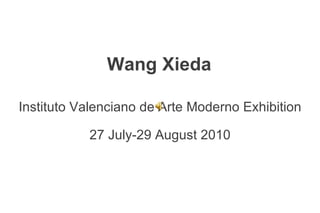
Wxd Ivam Exhibition Presentation
- 1. Wang Xieda Instituto Valenciano de Arte Moderno Exhibition 27 July-29 August 2010
- 2. Chinese characters, as a continuation of hieroglyphs that have been used throughout human civilization, are still very much alive today. Ancient Chinese characters began to take shape during the Banpo Culture period over 6,000 years ago. A complete text system appeared for the first time in Chinese history during the Shang Dynasty of 14th Century BC. Like all ancient civilizations, China's first characters were based on depictions of natural images; because of this fact there is a theory within traditional Chinese art that calligraphy and painting share the same origin. As a devoted researcher of text and calligraphy for the past twenty years, Wang Xieda is not merely a follower of ancient China but of all the world's ancient civilizations. After years of studying, he discovered that many of the Pictographs of early human civilizations had similarities. Pictographs are the most common means to represent nature by summarizing abstract forms in simple metaphors. In all visual forms, lines are the most basic and effective language for communication and dissemination. In ancient Chinese art, concepts that are similar to minimalism had already emerged as early as 2000 years ago; at the time, philosopher Lao Tzu wrote in his famous Tao Te Ching, “The way creates one, one creates two, two creates three, and three creates every being.” Wang Xieda’s recent works have used a tasteful and sedate ancient style and a refreshing and elegant rhyme, recalling the aesthetic origins of ancient civilizations. Usually relying on simple and unpretentious lines, his sculptures and paintings construct concise and unpredictable moldings. Among these visual forms, like primitive totems and early calligraphic symbols, Wang explores an abstract and purely aesthetic feeling, perfectly grasping the pulse of dimensions, and appropriately creating the rhythm of space. The momentary resonance produced at the instance when the creator and the viewers see a certain eternal beauty of concision is the reason that many viewers fall in love with Wang’s works.
- 3. Facing the changes of the 21st Century, each nation’s cultural traditions must find a new contemporary language to keep pace with time’s alteration of aesthetic expressions. This is the only for younger generations to be able to voluntarily study and inherit traditions. As an artist, Wang has been working to pursue the common human aesthetic experience. These efforts do not simply reiterate the past but rather use the simplicity and breadth of ancient art to re-create. It is his clear interpretation of the ancient language with today's syntax which expresses his personal experiences and emotions. Such efforts make his art both contemporary and timeless. In complicated and variable surroundings, we may perceive a composed and easy confidence from Wang Xieda’s works, such as in his proficient expression of national aesthetics. This exhibition at IVAM is Wang's debut solo exhibition outside of China. We truly hope his work will be appreciated and well perceived by western viewers.
- 31. Wang Xieda works on the installation piece, painting charcoal powder on white sand
- 32. Charcoal painting on white sand
- 33. The finished charcoal painting on white sand, with reflection of the installation.